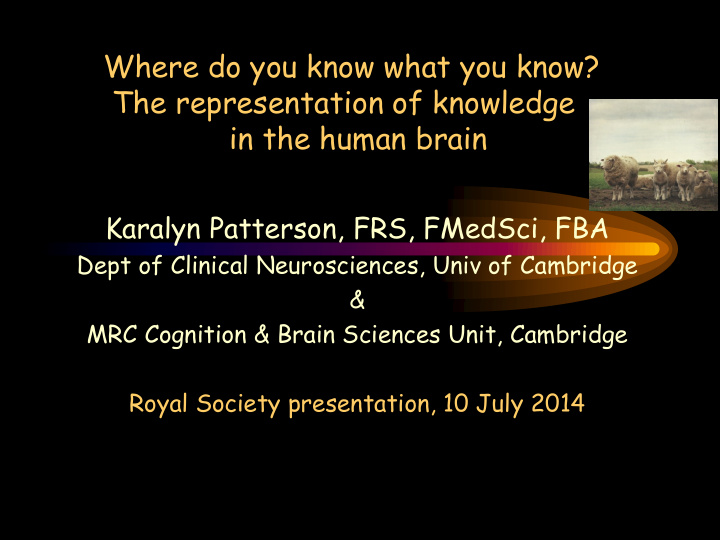



Where do you know what you know? The representation of knowledge in the human brain Karalyn Patterson, FRS, FMedSci, FBA Dept of Clinical Neurosciences, Univ of Cambridge & MRC Cognition & Brain Sciences Unit, Cambridge Royal Society presentation, 10 July 2014
Reasons for studying neurodegenerative diseases 1. Progress towards treatment (cure, prevention) 2. Functions disrupted by brain disease: how are they represented in healthy brain? Conceptual knowledge [aka semantic memory]: The things in our world: words, objects, animals, people Contrast between episodic & semantic memory Semantic knowledge of sheep: wool “baa” lamb etc Episodic memory = principal deficit in Alzheimer’s disease Is there a brain disease that attacks semantic memory?
Semantic dementia (SD): FTLD spectrum TAR DNA-binding protein 43 Predilection for anterior, inferior temporal lobes VBM for VBM for 6 SD 6 SD cases cases 8 M arch 2003 S c i e n c e W e e k C a m b r i d g e 2 0 0 3 deterioration of semantic memory
What characterises the deterioration? Stage of disease Familiarity of stimulus (object, word, person) Specificity of knowledge required Typicality of concept and/or its features 1 st 3 demonstrated by one study: Array of 7 object pictures Examiner says name of 1 Patient is asked to point to corresponding picture
WP-Matching: unrelated distractors Which one is the kingfisher?
WP-Match: Vaguely related distractors Which one is the kingfisher?
WP-Matching: Close distractors Which one is the kingfisher?
WP-Matching: very close distractors Which one is the kingfisher?
SD patients’ performance illustrating the impact of disease severity, stimulus familiarity and knowledge specificity 1.0 Proportion correct Unrelated Vaguely related 0.8 Close Very close 0.6 0.4 0.2 0 Hi Fam Lo Fam Hi Fam Lo Fam Milder patients More severe patients (n=6) (n=5)
Impact of typicality: SD Picture naming “dog” “dog” “dog” “animal” “little thing”
Impact of typicality Immediate and delayed copy drawing
Where do you know what you know? Modality specific details = widely distributed cortical network But all interconnected to semantic ‘hub’ in anterior, inferior temporal cortex which represents coherent concepts
Thank you for listening And with heartfelt gratitude to my research colleagues: John R Hodges Matthew A Lambon Ralph James L McClelland Peter J Nestor Timothy T Rogers Anna M Woollams
Recommend
More recommend